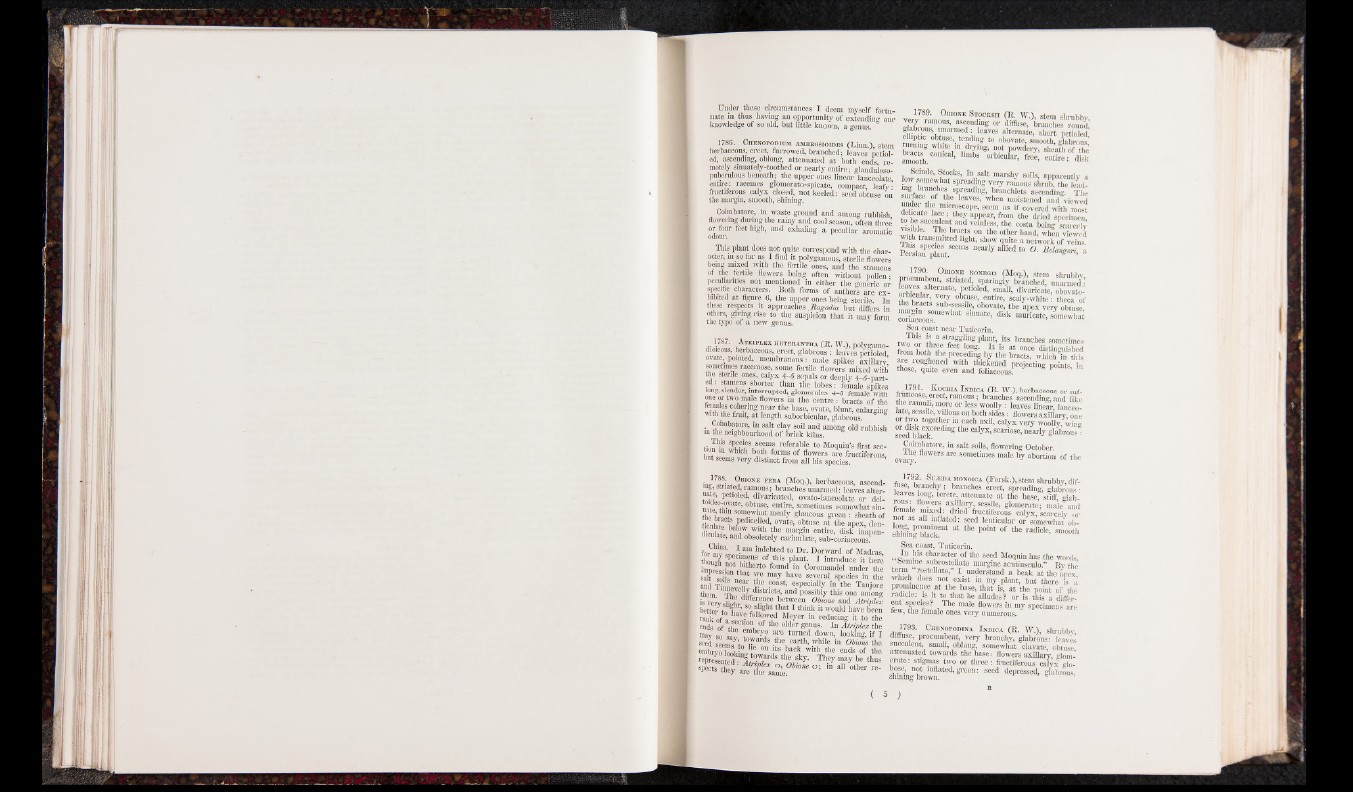
nate m tnus navmg an opportunity of extending our
knowledge of so old, but little known, a genus.
1786. Chenopodium ambrosioides (Linn.) stem
herbaceous, erect, furrowed, branched; leaves petiol-
ed, ascending, oblong, attenuated at both ends remotely
sinuately-toothed or nearly entire; glanduloso-
puberulous beneath; the upper ones linear lanceolate
entire: racemes glomerato-spicate, compact, leafy-
fructiferous calyx dosed, not keeled: seed obtuse on
the margin, smooth, shining.
Coimbatore, in waste ground and among rubbish
flowering during the rainy and cool season, often three
or four feet high, and exhaling a peculiar aromatic
odour.
This plant does not quite correspond with the char-
acter, inso far as I find it polygamous, sterile flowers
berng mixed with the fertile ones, and the stamens
or the fertile flowers being often without pollen •
peculiarities not mentioned in either the generic or
specific characters. Both forms of anthers are exhibited
at figure 6, the upper ones being sterile. In
these respects it approaches Ragodia but differs in
others, giving rise to the suspicion that it may form
the type of a new genus.
1787. At k ipm x HBTMtANTm (B. W .), polygamo-
dioicous, herbaceous, erect, glabrous: leaves petioled.
ovate^ pointed, membranous: male spikes axillary
sometimes racemose, some fertile flowers mixed with
the sterile ones, calyx 4 -5 sepals or deeply 4-5-part-
ed. stamens shorter than the lobes: female-spikes
long, slender, interrupted, glomerales 4 -5 female with
one or two male flowers in the centre : bracts o f the
femalra cohering near the base, ovate, blunt, enlarging
with the fruit, at length suborbicular, glabrous. ^
. Coimbatore, in salt d ay soil and among old rubbish
in the neighbourhood o f brick kilns.
tJ t s m S M referable to Moquin's first sec-
hon m which both forms of flowers are fructiferous,
but seems very .distinct from all his species.
„,„7 muons, ascending or difluse, branches round
glabrous, unarmed: leaves alternate, short petioled’
elliptic obtuse, tending to obovate, smooth, gtobrons,’
W S m m diying, not powdery, sheath of the
’ bmbs or^icu*ar) free, entire; disk
Scinde, Stocks, in salt marshy soils, apparently a
jujMg B W f l « Sspprreeaad?i"ngg, Tbr7an chlets ascendinthg.e l Tl ih-e
B B H S Q S l6aTeS’ When moist™ed and viewed
adeShdccaittee lLacee , 3Sthsecyo paep’p seeaeri,V lrosm thCe0 Tderriee<di wspitehc immeonst
visible. TTh e»’ bl ractsT oeMn ethf e’ oththee re ohsatnad ,b ewinhgen S cvaiercweelyd
H ^™s.uutted bgbt. show quite a network of veins.
& X t SMmS nearl7aUiedt0 Belavgeri, a
1790. Obione konegu (Moq.), stem shrubbv
striated, sparingly branched, unarme /’
W m m P.etl0led’ small, divaricate, obovato-
oibiculai, very obtuse, entire, scaly-white: theca of
the bracts sub-sessile, obovate, the apex very obtuse
Si“ ’ disk som ew S
Sea coast near Tuticorin.
tw om f t “ S ^ s ’to g p ta t, its branches sometimes
fromE9m h S|h - B 1 once distinguished
Ivom,^ 0 tE the, Preceding by the bracts, which in this
X l i 0Ugl?ened mth thickened projecting points, in
those, qmte even and foliaceous! ’
a ' -Lochia Inpica (R. W.), herbaceous or suf-
nuticose, erect, ramous; branches ascending, and like
lfaatet^/s2ess5u1e’, mv?ilnlo6 u°sr o lne lbSo Tth° s°iUdeys: : leflaovwees rlsi naex®irll>a lrayn,c oenoe-
or two together m each axil, calyx very woolly, wine
s L d t h S “ ^ “8 °aIyX’ soariose> glrtirous®
Coimbatore, in salt soils, flowering October
0Tlb e flowers are sometimes male by abortion of the
l ™*k (Moq.), herbaceous, ascend-
„ft,1 v™!?“8 >.branchesunarmed: leavesalter-
i petioled, divaricated, ovato-lanceolate or del-
1 H B S I obtuse’ entire. sometimes somewhatsin-
f! M f f i B H i l i B glaucous green: sheath of ^Pnamellcd, ovate, obtuse at the apex, den-
■ ■ ■ I margin entire, disk inupeu-
j CUate> “ d obsoletely cariuulate, sub-coriaceous'
fornw^'uoJ’ “ “ d! bted t0 Dr- Dorward of Madras,
■ » ■ ■ H i plant- 1 “ trodace it here
tomlision tw hert° f°™? D Coromand«il mder tie
i — BUI TTe “ ay liave several species in the
; and T i n L S ?oa?t’ esPeclalIy “ the Tanjore
them Thf°dMFilStriCtf’ and possibly tllis one among
is verv «lift*™faSIï e between Olrione and Atnplex
better tn ho’ SCp ®^Sht that I think it would have been
i H M B “ ‘owed Meyer in reducing it to the
ends of m H I of 016 older g«™6- I» Atnplex the
nay so »„v f 1“7? ” e turned d°™. looking, if I
seed s e e m V T " * -5be, earth, while in Obume the
embryo ,lts ba<* Wlth tbe o n * of the
represented ■ h B B | ^ e y may be thus
tpects t h e y 'a ^ f s a S e “ aU other re-
1792. SuaEDA monoica (Forsk.), stem shrubbv, diffuse,
branchy; branches erect, spreading, glabrous •
leaves long, terete, attenuate at the base* stiff, glabrous:
flowers axillary, sessile, glomerate; male and
female mixed: dried fructiferous calyx, scarcely or
not at all inflated: seed lenticular or somewha/obsSSng
blaSent at the P0int °f the radicle’ smooth
Sea coast, Tuticorin.
n o 31 -ds c^1?racfcer of the seed Moquin has the words
bemme subrostellato margine acutiusculo.” Bv the
te™ rostellato,” I understand a beak at the apex
which does not exist in my plant, but there is a
prominence at the base, that is, at the point of the
radicle: is it to that he alludes? or is this a differ-
JP* sPecies? The male flowers in my specimens are
tew, the female ones very numerous.
1793. Chenopodina I ndica (R. W .), shnibbv
diffuse, procumbent, very branchy, glabrous: leaves
succulent, small, oblong, somewhat clavate, obtuse
attenuated towards the base: flowers axillary, glomerate
: stigmas two or three: fructiferous calyx glo-
bose, not inflated, green: seed depressed, glabrous
shining brown. 6 ’